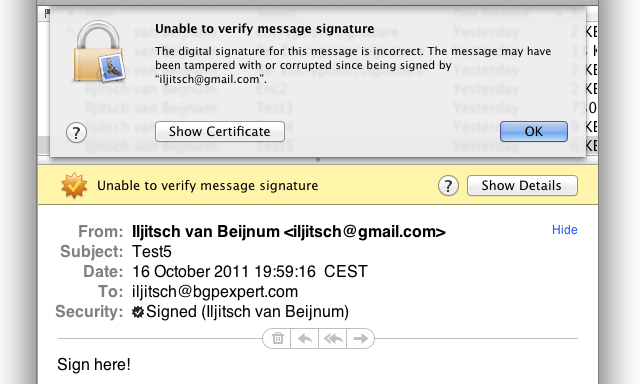
- MAC OS X SERVER CREATE SELF SIGNED CERIFICATE FOR EMAIL MAC OS X
- MAC OS X SERVER CREATE SELF SIGNED CERIFICATE FOR EMAIL MAC OS
- MAC OS X SERVER CREATE SELF SIGNED CERIFICATE FOR EMAIL UPDATE
- MAC OS X SERVER CREATE SELF SIGNED CERIFICATE FOR EMAIL FULL
You will need to download the Entrust CA intermediate certificate.Ħ. Note there is an error "This certificate was signed by an unknown authority". There, you will see the imported certificate with the identity related to the email address for which it was made. In Keychain Access, on the left-hand menu under Category go to Certificates. If not, you can find it in your apps by searching for "keychain".ĥ. The Keychain Access app should open automatically after providing the password. Provide the same password provided in step 2.Ĥ. You will be asked to provide a password to open the file. Enter the password you used when you placed order or created certificate using ECS Enterprise account.ģ. Note the below image shows a pick-up email for a personal S/MIME, however this process is the same regardless if you've obtained a personal S/MIME from our retail site, or if you've obtained an Enterprise S/MIME issued to you from an ECS Enterprise account.Ģ. Click on the link in your certificate pickup email. Part 1 of 3: Importing S/MIME certificate to Keychain Access 1.
MAC OS X SERVER CREATE SELF SIGNED CERIFICATE FOR EMAIL MAC OS
You may need to reboot, but your certificate should now work in Chrome and Safari on your local machine.Purpose: Secure Email (S/MIME) certificate installation guideįor Secure Email (S/MIME) certificate on Apple Mail on Mac OS Xġ) Importing S/MIME certificate to Keychain AccessĢ) Sending digitally signed and encrypted messages with Apple Mailģ) Storing a contact's Secure Email certificate (S/MIME exchange) Lastly, repeat the process of dragging and giving access in the System Keychain. crt file.ĭouble click, and change the settings for the selected certificate to "Always Trust". Then from the open Finder window, drag and drop your. In the Keychain Access application, select the login Keychain and the Certificates Category. $ open /Applications/Utilities/Keychain\ Access.app Next we will open your Apache ssl directory and the "Keychain Access" application: $ open /etc/apache2/ssl

SSLCertificateKeyFile "/private/etc/apache2/ssl/.key" Chrome / Safari Configuration SSLCertificateFile "/private/etc/apache2/ssl/" Next, inside your sites block, append the following, adjusting the filenames accordingly. Presuming your sites VirtualHost is in /etc/apache2/extra/nf either change to, or duplicate your VirtualHost entry using if you'd like your VirtualHost accessible with and without SSL. $ openssl req -newkey rsa:2048 -x509 -nodes \Įither comment out using a # at the start of each line, or delete every single line between the opening and the closing around line 290. The subjectAltName=DNS piece of this is required to get Chrome versions greater than 58 working.
MAC OS X SERVER CREATE SELF SIGNED CERIFICATE FOR EMAIL FULL
Replace all four entries with your full intended development subdomain.

Next we will generate your key and certificate. We need to do this outside of sudo requiring areas due to some bugs with the Apple version of openssl. Creating the Certificatesįirst off we'll make place to do our work. This tutorial assumes you are using the built in version of Apache that comes with macOS, however you should be able to adjust paths for brew or otherwise installed versions. I found a number of tutorials of varying quality online, but none of them did the full process from start to finish, particularly solving problems with Chrome 58. app however means having to get SSL working. It makes working with CORS and cookies a lot simpler for applications with APIs on subdomains.ĭoing this with. I like to set up my dev environments as subdomains of my actual domain, such as. app domains are interesting as they require SSL at all times. I would recommend the mkcert method unless you have a reason you explicitly need a self signed certificate.
MAC OS X SERVER CREATE SELF SIGNED CERIFICATE FOR EMAIL UPDATE
Update : A much simpler method using a tool called mkcert has come along and I have an updated walkthrough you may want to use instead.
MAC OS X SERVER CREATE SELF SIGNED CERIFICATE FOR EMAIL MAC OS X
Comments: 9 Tags: Walkthrough SSL MacOS Mac OS X Apache By Jesse Donat on May.


 0 kommentar(er)
0 kommentar(er)
